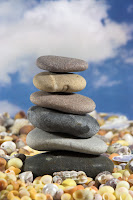I just completed a wonderful 4-week meditation workshop, and in their feedback the participants mentioned how good it was to be able to share the journey into meditation with others who were understanding, kind and supportive. Even in such a short time, (an hour and a half once per week for four weeks), there was a sense of community and shared intention that provided support for all those who were in it. Meditation in many ways is a seeking into oneself, and yet this inner seeking is easier to do with the support of others.

Recently I’ve been thinking a lot about this sense of community and how we connect and separate ourselves from each other. From a yogic point of view, the sense of an individual self is an illusion. “No man is an island” was an old tune I used to hear my parents listen to as a child. “No man is an island, no man stands alone. Each man’s joy is joy to me, each man’s grief is my own. We need one another, so I will defend each man as my brother, each man as my friend.” (Of course as a kid I wondered “what about the women?” but in the interest of the deeper meaning, we’ll let that pass for now!)
All the world religions teach that we should care for our fellow human. Yet watching the political news over the last few years, it has become so evident that we don’t, as a culture, live by that maxim. In fact, our culture seems to be becoming more and more polarized into “us” and “them” and all based on ideas, thoughts and opinions, and the fear of these being somehow threatened and destroyed. We identify with these opinions and beliefs and therefore when they are threatened, it is perceived as a threat to our very identity.
Even as yogis we are not immune from “separation-thinking.” How often do yoga practitioners defend their chosen style of yoga as “better” or “more effective” than another? Whenever we identify with a practice, an idea, or a way of being (what the yogis call ahamkara), we run the risk of thinking that we are that. What follows is the assumption that “I am right” from which the logical premise that seems to follow is “they are wrong.” Yet with billions of people on the planet, all with their own collection of interests, constitutional predispositions and life experiences, how is it possible that there could only be one way for us all to be, think or believe?
From a yogic perspective, we are not separate – we are manifestations of the same stuff – awareness, life force, whatever you choose to call it – we are manifestations of the substance of life which is One and yet each of us is a unique expression of that One. Goswami Kriyandanda describes each person as a microcosm of the whole. Just imagine - you are a hologram of the whole Universe!

We are all the same stuff – just packaged in a different way, yet we spend so much time, energy and effort feeding the illusion of our separateness – this sense of “I, me and mine” that yogis call asmita. The thing about feeding our sense of separation is that it also creates a sense of isolation and brings very little satisfaction. When we build walls to keep ourselves, our opinions and our beliefs protected and safe, those walls also keep others out. Those walls prevent us from hearing other people, from having sympathy and understanding, from recognizing in “others” not only our own brilliance, but also our own shadow. And if we are too afraid or too ashamed to see ourselves clearly, we run the risk of projecting our own disfunction on to others and condemning them for it. On the other hand, if we are able to really see ourselves with compassion, and even with humor, we can begin to free ourselves and to break down the walls that separate us from each other.
I remember the first time, as a teenager, that I realized that I wasn’t the only one with a particular trait of which I had been ashamed. I had perceived this trait (can't even remember what it was now) as a personal failing and when I found out someone else had it too, it was amazing! I remember the sense of relief and freedom when I realized I was "only human." I could let go of that burden and stop blaming myself for not being perfect. Being in a supportive community provides the opportunity to see yourself in others and be accepted as you are. But you can do that for yourself and for others at any time if you think of all of humanity (and even all sentient beings) as your "community." Meditation is one way practice seeing yourself with gentleness and compassion, accepting yourself as you are – hang-ups, past life history, neurosis, judgments, opinions and all. It all begins with the choice to accept ourselves as we are, with love & a healthy dose of light-heartedness. Then we can create and/or find supportive communities where we can share this loving acceptance with others.
What if we were to just expect loving support from our communities and especially from ourselves? I wonder what would happen then?
In loving acceptance of you, just as you are...
Namaste.








